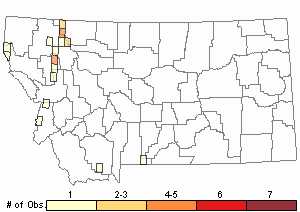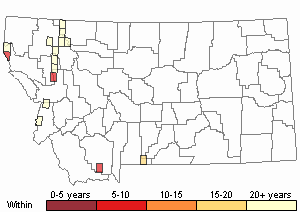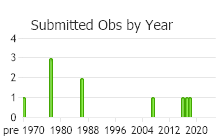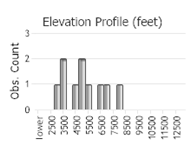View in other NatureServe Network Field Guides
NatureServe
Montana
Utah
Wyoming
Idaho
Wisconsin
British Columbia
South Carolina
Yukon
California
New York
A Pseudoleskea Moss - Pseudoleskea patens
Other Names:
Lescuraea patens
General Description
Plants: Pleurocarpous, growing in slender interwoven mats, deep green, olivaceous, or seldom green with yellow tones, becoming brown over time. Stems thin to sizeable, catkin-like with the tips occasionally hooked upward, freely branched (FNA 2014), 1-6 cm in length (Lawton 1971), possessing a central strand; paraphyllia numerous; rhizoids borne in groups on leaves near the leaf attachment (FNA 2014).
Leaves: Lying next to the stem and overlapping when dry, spreading a little to about 45 degrees when damp, not shiny, 0.6-1 mm in length, seldom curved in sickle-like fashion, egg-shaped, narrowing suddenly to an acute leaf tip or seldom to a short acumen, without a hair-point (FNA 2014); leaf edges curved back and downward from the bottom nearly to the leaf tip or margins flat in places (Lawton 1971), smooth to finely saw-toothed above (FNA 2014); costa disappearing well before the leaf tip (Crum and Anderson et al. 1981), faintly wavy, sometimes tinged with orange. Branch and stem leaves comparable (FNA 2014), or branch leaves a bit smaller, usually with the tip finely saw-toothed (Lawton 1971).
Leaf Cells: Lower laminal cells generally shorter but otherwise resembling medial cells; medial cells square (FNA 2014), unipapillose on both surfaces (Crum and Anderson et al. 1981), the papillae short and rounded, occasionally not centered over the lumen, with thick, nonporose walls; alar cells square to somewhat long, the longer dimension crosswise to the leaf length (FNA 2014). Branch leaf medial cells square or occasionally somewhat long, papillose, the papillae of the longer cells situated distally on the cell (Lawton 1971).
Phenology
Fruit ripens in mid-summer (FNA 2014).
Diagnostic Characteristics
Characterized by short laminal cells and both leaf cell surfaces with 1 centrally-located and prominent papillae (Crum and Anderson et al. 1981).
Range Comments
North American Range
AK, NT, BC and AB s to CA, NV, UT and CO (FNA 2014). Known in Montana from Flathead, Glacier, Lake, Lincoln, Missoula, Ravalli, and Sanders Counties (Elliott and Pipp 2016).
Observations in Montana Natural Heritage Program Database
Number of Observations: 27
(Click on the following maps and charts to see full sized version)
Map Help and Descriptions
Relative Density

Recency



 (Observations spanning multiple months or years are excluded from time charts)
(Observations spanning multiple months or years are excluded from time charts)
Habitat
Protected or exposed stones and crags, soil, along watercourses. Occurring from mid-elevations to 11,480 feet (FNA 2014)
Reproductive Characteristics
Dioicous. Perigonial leaves egg-shaped, smooth-margined, with 5-8 antheridia. Seta 7-25 mm tall (Lawton 1991). Capsule 0.5-2 mm in length (FNA 2014), tilted to level; exostome teeth ochre, with delicate transverse lines, slightly taller than the endostome processes; endostome processes perforate on the keel; cilia frequently rudimentary and sometimes absent (Lawton 1971).
Stewardship Responsibility
References
- Literature Cited AboveLegend:
 View Online Publication
View Online Publication Crum, H.A. and L.E. Anderson. 1981. Mosses of Eastern North America. 2 volumes. Columbia University Press, New York. 1328 pp.
Crum, H.A. and L.E. Anderson. 1981. Mosses of Eastern North America. 2 volumes. Columbia University Press, New York. 1328 pp. Elliott, J.C. and A.K. Pipp. 2018. A Checklist of Montana Mosses (1880-2018). Updated 3 January, 2020. Montana Natural Heritage Program, Helena, Montana. 73 pp.
Elliott, J.C. and A.K. Pipp. 2018. A Checklist of Montana Mosses (1880-2018). Updated 3 January, 2020. Montana Natural Heritage Program, Helena, Montana. 73 pp. Flora of North America Editorial Committee, eds. 2014. Flora of North America North of Mexico. Volume 28. Bryophytes: Mosses, Part 2. Oxford University Press, Inc., NY. xxi + 702 pp.
Flora of North America Editorial Committee, eds. 2014. Flora of North America North of Mexico. Volume 28. Bryophytes: Mosses, Part 2. Oxford University Press, Inc., NY. xxi + 702 pp. Lawton, E. 1971. Moss Flora of the Pacific Northwest. Hattori Botanical Laboratory. Japan: Yamabuki-cho, Shinjuku-ku, Tokyo. 362 pages plus appendices.
Lawton, E. 1971. Moss Flora of the Pacific Northwest. Hattori Botanical Laboratory. Japan: Yamabuki-cho, Shinjuku-ku, Tokyo. 362 pages plus appendices.
- Additional ReferencesLegend:
 View Online Publication
View Online Publication
Do you know of a citation we're missing? Elliot, J. C. 1993. Second checklist of Montana mosses. Unpublished report. U.S. Forest Service, Region 1. Missoula, MT. 45 pp.
Elliot, J. C. 1993. Second checklist of Montana mosses. Unpublished report. U.S. Forest Service, Region 1. Missoula, MT. 45 pp. Flowers, S. 1973. Mosses: Utah and the West. Brigham Young University, Provo, Utah. 567 p.
Flowers, S. 1973. Mosses: Utah and the West. Brigham Young University, Provo, Utah. 567 p. Lawton, E. 1971. Keys for the Identification of the Mosses on the Pacific Northwest. Reprinted from 'Moss Flora of the Pacific Northwest'. Published as Supplement No. 2 of the Journal of the Hattori Botanical Laboratory. Nichinan, Miyazaki, Japan. 66 pp.
Lawton, E. 1971. Keys for the Identification of the Mosses on the Pacific Northwest. Reprinted from 'Moss Flora of the Pacific Northwest'. Published as Supplement No. 2 of the Journal of the Hattori Botanical Laboratory. Nichinan, Miyazaki, Japan. 66 pp. Malcolm, B., N. Malcolm, J. Shevock, and D. Norris. 2009. California Mosses. Nelson, New Zealand: Micro-Optics Press. 430 pp.
Malcolm, B., N. Malcolm, J. Shevock, and D. Norris. 2009. California Mosses. Nelson, New Zealand: Micro-Optics Press. 430 pp. Smith, A.J.E. 1980. The Moss Flora of Britain and Ireland. Cambridge University Press, Cambridge. 705 pp.
Smith, A.J.E. 1980. The Moss Flora of Britain and Ireland. Cambridge University Press, Cambridge. 705 pp.
- Web Search Engines for Articles on "A Pseudoleskea Moss"





